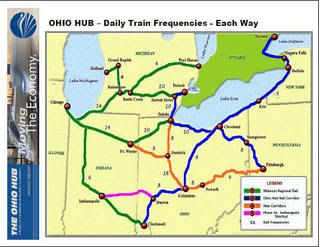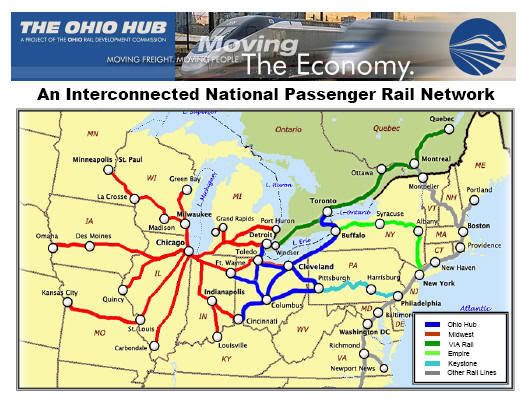(4 pm. – promoted by ek hornbeck)
{Reprinted from the Hillbilly Report.org, April 21, 2009.}
{ Except for updating images to correct for link rot, edits in braces and italics.}
 This last weekend I wrote up a small diary, cross-posted to various places … which even stumbled into being wrecklisted at Agent Orange … about the High Speed Rail plan released by the Obama administration.
This last weekend I wrote up a small diary, cross-posted to various places … which even stumbled into being wrecklisted at Agent Orange … about the High Speed Rail plan released by the Obama administration.
That diary focused on laying out the three “tiers” of HSR in the announced plan. “Express HSR” is one of the bullet train systems, like they are planning for California. But between that tier and conventional rail, are two more tiers:
- “Regional HSR”, with a top speed of around 125mph, able to provide trips at average speeds in the range of 100mph, operating in existing rail rights of way, but mostly on its own track, with upgraded signaling and substantial investment in grade separation and/or the top level of “hardened” level crossings, normally with electrified lines; and
- “Emerging HSR”, with a top speed of 110mph, able provide trips at average speed in excess of 80mph, operating on existing rail right of way with improved capacity, but sometimes sharing track with freight rail, the 110mph standard of quad gate, speed sensitive level crossings, and provided by either electric or diesel 110mph tilt-trains
The bullet trains are the show ponies … but for small town and rural America, the genuine seat at the table for Emerging and Regional HSR is the real good news from the announcement.
Now, I do not want to give the impression that Express HSR is somehow “anti-rural development”. Far from it … all forms of HSR share a key feature that is very good news for small town and rural America.
Trains lose much less time on a stop than airplanes do. And while an Express HSR route might be built in order to serve transport markets between two big metro areas … you need two way track pretty much all the way to run them properly, and once you have it, adding services to serve smaller cities in between is very cost efficient.
That doesn’t mean a station in every little village and hamlet, but it does mean that there can be a station every thirty to fifty miles, which means the areas that the HSR passes through are likely to see far more frequent services at the closest HSR station than at the closest airfield.
So, compared to the current state of affairs, there are going to be more rural areas with more effective transport options in reasonable driving distance with “Express HSR” than with the two level system of short-hop flights and interstate buses.
Cost Matters
No, what makes the seat at the table for Emerging HSR and Regional HSR so exciting is that they cost so much less per mile to get built.
Consider that basically one Express HSR corridor from San Francisco to San Jose through the Central Valley then LA and ending in Anaheim California … {was} projected to cost $46b, {and is now projected to cost $68.4b due to project design inflation, reaction to NIMBY opposition driving further design inflation, and an increase in underlying cost estimates due to difficulty geography descending into the San Fernando Valley.}
 However, to build the Ohio Hub for 110mph service (blue and orange lines) would cost under $10b … maybe under $5b. That’s Buffalo to Cleveland to Columbus to Dayton to Cincinnati … connecting to Indianapolis and Chicago, Pittsburgh to Cleveland to Toledo to Fort Wayne …. connecting to Chicago, Pittsburgh to Columbus to Toledo to Detroit, and Pittsburgh to Columbus to Fort Wayne.
However, to build the Ohio Hub for 110mph service (blue and orange lines) would cost under $10b … maybe under $5b. That’s Buffalo to Cleveland to Columbus to Dayton to Cincinnati … connecting to Indianapolis and Chicago, Pittsburgh to Cleveland to Toledo to Fort Wayne …. connecting to Chicago, Pittsburgh to Columbus to Toledo to Detroit, and Pittsburgh to Columbus to Fort Wayne.
The thing is, when existing rail sees light freight traffic, it can be upgraded, 10miles of passing tracks added in each 50 miles of track, when existing rail sees heavy freight traffic, a new passenger track can be laid … and all in existing rail rights of way. Most of the worst headaches of establishing a new rail line in terms of environmental clearances, property fights, etc, … just are not there when building inside an existing rail right of way.
The track is built for 60mph freight traffic, and then the extra tilt that has to be added to allow trains to go through turns at 110mph without tossing the passengers around is added by the train itself.
And consider the stations …

… while it is patronage involving the three largest cities in that provides the financial foundation for the Ohio Hub system, once the rail line is passing through, it makes sense to add a station every so often, to get an additional increment of passengers.
And so there are stations laid out in Coshocton, Springfield, Kenton, New Castle PA, Findlay, Defiance … a lot more stations a lot more accessible to the rural counties of the state than a single Express HSR system could be, and for less money.
And its not just the Regional HSR Systems
 The red corridors in that map is the Midwest Hub … one of the main inspirations of the Ohio Hub, as the Midwest Hub was originally to connect to Cleveland and Cincinnati, and someone said, “Hmmm, something seems to be missing here”.
The red corridors in that map is the Midwest Hub … one of the main inspirations of the Ohio Hub, as the Midwest Hub was originally to connect to Cleveland and Cincinnati, and someone said, “Hmmm, something seems to be missing here”.
The Midwest Hub is a product of the Midwest Interstate Passenger Rail Commission (FAQ), an alliance of states.
And the membership of the MIRPC extends beyond the boundaries of the Midwest Hub, extending on to North Dakota.
North Dakota? Why are they a member of the alliance?
Note that North Dakota may not {host a Midwest Hub corridor}, but rail is still important to North Dakota. The transcontinental Amtrak system is quite important for many North Dakota towns and rural counties. And so the Midwest Hub will benefit North Dakota in two main ways:
- First, the Amtrak to Minneapolis will then connect to a Regional HSR corridor to Chicago, offering a substantially quicker train trip than what is currently available; and,
- Second, when the Amtrak is running through an area with a Regional HSR system, it will be able to use the improved track as well, avoiding the delays from freight trains that currently plague the transcontinental routes and can put them many hours behind schedule.
Getting down to work
Note that the plan set down is not a centralized, top-down plan. It involves states, one at a time or in groups, sitting down, deciding what kind of improved rail service would benefit them, working out a desired alignment, and going through the process to get it added to one of the existing systems of HSR corridors.
Some states have taken a lead, like the alliance led by Illinois, and the Southeast corridor led by Virginia and North Carolina.
Some states are scurrying to catch up, like Colorado, which started studying a corridor from Cheyenne through Denver and Colorado Springs to the New Mexico border last year.
Some states have had stop-start-stop approaches, like Florida and Texas, both of which almost got started on HSR systems, and both of which had their HSR projects killed by a Governor Bush.
And some states have lagged behind. There ought to be a Southeast hub spreading out from Atlanta, similar to the one spreading out from Chicago, but Georgia seems content to sit on its hands, letting others do the work{, though, as covered in a recent Sunday Train, they are at least proceeding with planning the corridors for a Southeast Hub.} And Tennessee seems to be completely asleep at the wheel. That means obvious lines, like Atlanta to Nashville connecting to the Midwest Hub at Louisville, are missing.
But the advantage of the system is that we do not need to get heard over the noise in Washington DC in order to get the ball rolling in our own neck of the woods. What we need to do is to corral our own State Legislator, State Senator, even Governor, and talk to them about when they are going to get off their fat asses and get to work on working up a Regional HSR system to serve both the cities in their states and the country in between the cities that the rail lines will pass through.

1 comments
Author